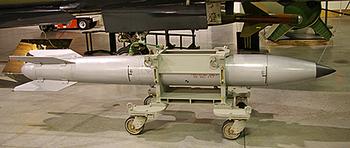
U.S. Air Force F-15E Strike Eagles assigned to the 494th Fighter Squadron sit on the flight line at RAF Lakenheath, England, in October 2023. Federal government website solicitations indicate that the U.S. may be moving some of its nuclear weapons to the base. (Olivia Gibson/U.S. Air Force)
A notice on a public federal website indicates that Washington may move some of its nuclear arsenal to the United Kingdom, amid concerns that tactical nuclear weapons are a growing part of Russian military strategy.
A solicitation published last week on the U.S. government’s official contracting website refers to the need for “imminent surety support” at RAF Lakenheath, home to the 48th Fighter Wing.
“Surety” is a term used by the Pentagon that refers to the ability to secure nuclear weapons safely.
The solicitation, first reported by London’s The Telegraph newspaper, advertises for hydraulic ramps for unloading vehicles at the base.
Air Force officials at Lakenheath declined to discuss the language in the latest government solicitation.
“It is U.S. policy to neither confirm nor deny the presence or absence of nuclear weapons at any general or specific location,” the 48th Fighter Wing said in a statement Monday.
It follows roughly a year of speculation that American nuclear weapons would return to the base, where they were housed during the Cold War but removed in 2008.

The B61 bomb is designed to be carried by aircraft at supersonic flight speeds and has been the primary nuclear weapon in the U.S. stockpile since the end of the Cold War. The U.S. is reportedly planning to move nuclear weapons to RAF Lakenheath, England, according to The Telegraph newspaper. (U.S. Air Force)
The Air Force’s 2024 estimated budget, released in March, mentioned the construction of a “surety dormitory” at Lakenheath. Construction is scheduled to begin in June and end in February 2026, according to budget documents.
A separate procurement contract in September also mentioned that the 48th Security Forces Squadron would have an “upcoming nuclear mission.”
The Telegraph reported that RAF Lakenheath is expected to house B61-12 gravity bombs.
Although neither American nor British officials normally say much about nuclear weapons sites, several locations have been made public over the decades.
In 2019, six locations in Europe were accidentally revealed in a report published by a NATO committee.
The report referred to about 150 nuclear weapons at six bases, including Aviano Air Base in Italy and Incirlik Air Base in Turkey, both of which are home to U.S. service members. Additional sites were located in Belgium, Germany, Italy and the Netherlands.
The contractor solicitations come as Russian nuclear saber-rattling has grown since the Kremlin’s invasion of Ukraine in February 2022.
Russia’s heavy losses to its conventional forces against Ukraine make it more likely to rely on tactical nuclear weapons in a hypothetical war with the NATO alliance, a study commissioned by U.S. European Command found. Such weapons have shorter range than the strategic missiles built to strike the United States.
“Russia probably would use (non-strategic nuclear weapons) at the theater level to ‘soberize’ the West into realizing that it should settle the conflict as quickly as possible, preferably on Russia’s terms,” said the report, which was released last week by the International Institute for Strategic Studies.
Also last week, Russian state media announced the creation of a nuclear bomb simulator designed to train Russian troops on how to operate following a radioactive blast.

A U.S. Air Force F-35A Lightning II assigned to the 495th Fighter Squadron takes off from RAF Lakenheath, England, Jan. 3, 2024. The aircraft has been repeatedly tested for the capability to deliver a nuclear payload. (Renee Nicole S.N. Finona/U.S. Air Force)